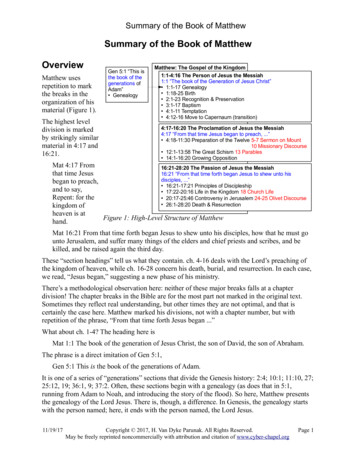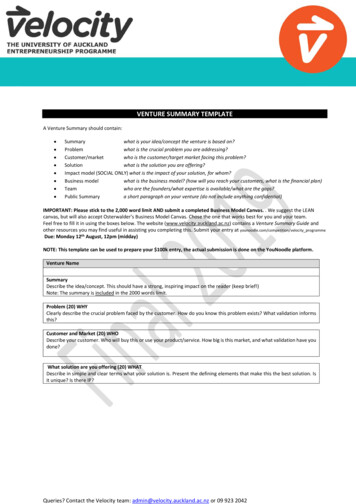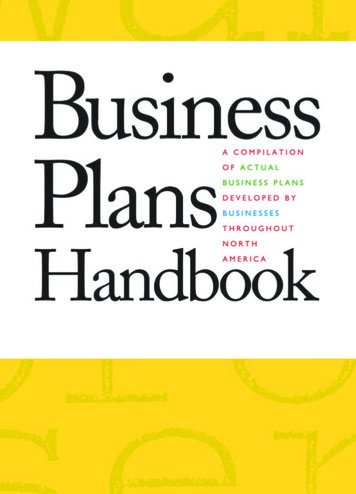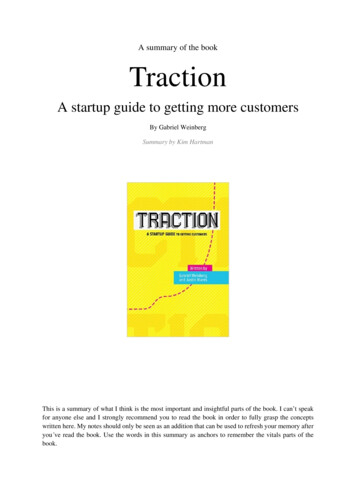
Transcription
Summary of the Book of MatthewSummary of the Book of MatthewOverviewMatthew usesrepetition to markthe breaks in theorganization of hismaterial (Figure 1).The highest leveldivision is markedby strikingly similarmaterial in 4:17 and16:21.Gen 5:1 “This isthe book of thegenerations ofAdam” GenealogyMatthew: The Gospel of the Kingdom1:1-4:16 The Person of Jesus the Messiah1:1 “The book of the Generation of Jesus Christ” 1:1-17 Genealogy 1:18-25 Birth 2:1-23 Recognition & Preservation 3:1-17 Baptism 4:1-11 Temptation 4:12-16 Move to Capernaum (transition)4:17-16:20 The Proclamation of Jesus the Messiah4:17 “From that time Jesus began to preach, .” 4:18-11:30 Preparation of the Twelve 5-7 Sermon on Mount10 Missionary Discourse 12:1-13:58 The Great Schism 13 Parables 14:1-16:20 Growing OppositionMat 4:17 From16:21-28:20 The Passion of Jesus the Messiahthat time Jesus16:21 “From that time forth began Jesus to shew unto hisdisciples, .”began to preach,16:21-17:21 Principles of Discipleshipand to say,17:22-20:16 Life in the Kingdom 18 Church LifeRepent: for the20:17-25:46 Controversy in Jerusalem 24-25 Olivet Discourse26:1-28:20 Death & Resurrectionkingdom ofheaven is atFigure 1: High-Level Structure of Matthewhand. Mat 16:21 From that time forth began Jesus to shew unto his disciples, how that he must gounto Jerusalem, and suffer many things of the elders and chief priests and scribes, and bekilled, and be raised again the third day.These “section headings” tell us what they contain. ch. 4-16 deals with the Lord’s preaching ofthe kingdom of heaven, while ch. 16-28 concern his death, burial, and resurrection. In each case,we read, “Jesus began,” suggesting a new phase of his ministry.There’s a methodological observation here: neither of these major breaks falls at a chapterdivision! The chapter breaks in the Bible are for the most part not marked in the original text.Sometimes they reflect real understanding, but other times they are not optimal, and that iscertainly the case here. Matthew marked his divisions, not with a chapter number, but withrepetition of the phrase, “From that time forth Jesus began .”What about ch. 1-4? The heading here isMat 1:1 The book of the generation of Jesus Christ, the son of David, the son of Abraham.The phrase is a direct imitation of Gen 5:1,Gen 5:1 This is the book of the generations of Adam.It is one of a series of “generations” sections that divide the Genesis history: 2:4; 10:1; 11:10, 27;25:12, 19; 36:1, 9; 37:2. Often, these sections begin with a genealogy (as does that in 5:1,running from Adam to Noah, and introducing the story of the flood). So here, Matthew presentsthe genealogy of the Lord Jesus. There is, though, a difference. In Genesis, the genealogy startswith the person named; here, it ends with the person named, the Lord Jesus.11/19/17Copyright 2017, H. Van Dyke Parunak. All Rights Reserved.May be freely reprinted noncommercially with attribution and citation of www.cyber-chapel.orgPage 1
Summary of the Book of MatthewIn addition to these section headings, Matthew uses repetition to mark off five long discourses bythe Lord, shown in red on Figure 1. Each of these ends with a similar summary (chart):Mat 7:28 And it came to pass, when Jesus had ended these sayings, the people wereastonished at his doctrine:Mat 11:1 And it came to pass, when Jesus had made an end of commanding his twelvedisciples, he departed thence to teach and to preach in their cities.Mat 13:53 And it came to pass, that when Jesus had finished these parables, he departedthence.Mat 19:1 And it came to pass, that when Jesus had finished these sayings, he departed fromGalilee,Mat 26:1 And it came to pass, when Jesus had finished all these sayings, he said unto hisdisciples,Some people1 suggest that we should organize Matthew around these five discourses, mimickingthe structure of the five books of Moses. Matthew draws many parallels between our Lord andMoses,2 in keeping with Moses’ promise in Deut 18:18 to “raise up a Prophet like unto”Moses. We’ll highlight some of these in this review, and the emphasis on five discourses maywell recall the five books of Moses, but they don’t clearly function either as introductions or assummaries of the material around them. We have seen that they do fit quite well into thestructural pattern that is driven by the introductions at 4:17 and 16:21.Again, there’s a lesson here: structural markers function at different levels, and often you have tostep back to see which ones make sense at the higher level, and which ones serve a lower-levelfunction (such as the conclusions marking off the five discourses).Let’s review the contents of these three sections in more detail.ch. 1-4, the Person of Jesus the KingThe first section establishes three thingsabout Jesus the Messiah that will beemphasized throughout the book: he is theSon of David, the Son of God, and theprophet like Moses (Figure 2, chart). 1:1-17 GenealogySon of David1:18-25 BirthProphet like2:1-23 Recognition & PreservationMoses3:1-17 BaptismSon of God4:1-11 Temptation4:12-16 Move to Capernaum (transition)He is presented as the Son of David in three Figure 2: Two themes in the first section ofways. First, his genealogy is structured into Matthewthree blocks of 14 names each. Matthew has omitted some names from the OT to reach thisnumber, which is the value of the name “David” if read as a Hebrew number (Figure 3). Second,the angel emphasizes that Joseph, into whose home he is born, is “Son of David” (v. 20). Third,the wise men come seeking “the king of the Jews,” a position that belongs to David’s offspring,according to 2 Samuel 7.The birth story also begins to develop the theme that he is God’s son, with the two names given1 Notably B.W. Bacon, dating back to 1918; see references in D.R. Bauer, The Structure of Matthew’s Gospel,JSNT Supplements 31, Almond Press: Sheffield, 1989.2 These are conveniently discussed in D.C. Allison Jr., The New Moses: A Matthean Typology. Minneapolis, MN:Fortress, 1993.11/19/17Copyright 2017, H. Van Dyke Parunak. All Rights Reserved.May be freely reprinted noncommercially with attribution and citation of www.cyber-chapel.orgPage 2
Summary of the Book of Matthewhim. א a 1David ב a 2 ג a 3 ד a 4 ה a 5 4 6 4 ו a 6 14.Figure 3: Davidicsignificance of thenumber 14 The angel calls him “Jesus,” which means “Jehovah is Salvation,” andMatthew adds that his birth fulfill the promise of Isaiah 7:14 that he isImmanuel, “God with us.” Chapter 2 continues to emphasize that he is God’s son by showing himreceiving worship from the Wise Men. This is the first of several placesin Matthew where the Lord Jesus receives worship; others are 8:2 (theleper), 9:18 (the ruler of the synagogue), 14:33 (the disciples, after hewalked on the water), 15:25 (the Canaanite woman), 20:20 (the motherof James and John), 28:9 (the women at the tomb), and 28:17 (the disciples in Galilee).Contrast his willingness to receive this worship with the attitude of the angels in Rev 19:10and 22:9; there is no instance of a godly person offering worship to a creature, or receivingworship, after the captivity.3 Then Joseph takes him into Egypt, which Matthew explains with Hos 11:1, where God says,“Out of Egypt have I called my Son.” In 3:17, at his baptism, God declares, “This is my beloved Son, in whom I am well pleased.” The heart of Satan’s temptation focuses on this claim, as twice he challenges the Lord, “Ifthou be the Son of God” (4:3, 6).Matthew repeatedly emphasizes the deity of the Lord. In this first section, he is “God with us,”and when John the Baptist is introduced in ch. 3, it is with reference to Isaiah’s prophecy,Mat 3:3 For this is he that was spoken of by the prophet Esaias, saying, The voice of onecrying in the wilderness, Prepare ye the way of the Lord, make his paths straight.In Matthew, John is preparing the way before Jesus, but the Lord in Isa 40:3 is יהוה .A third theme introduced in this section is that our Lord is the prophet like Moses (chart):Deu 18:15 The LORD thy God will raise up unto thee a Prophet from the midst of thee, ofthy brethren,like unto me;ExodusMatthewunto him yeJealous kingPharaohHerodshall hearken;Matthewemphasizes this bythe similaritybetween his birth(especially theopposition byHerod) and that ofMoses (and thepersecution byPharaoh) (Table 1),and his fast of fortydays in theThe rivalMosesBabySource of information aboutrivalDream (Targum)Wise menInterpretation of theinformationMagicians (Jannes andJambres) (Targum)Chief Priests and ScribesKing’s responseKill all the male childrenKill all the childrenNotification of (adoptive) fatherAmram (Targum)in a dreamDeliverance of the rivalAdoption by Pharaoh’sdaughterJosephAdoption & protection byson of DavidTable 1: Parallels between Pharaoh and Herod3 See notes on Matt 8:2 for detailed discussion.11/19/17Copyright 2017, H. Van Dyke Parunak. All Rights Reserved.May be freely reprinted noncommercially with attribution and citation of www.cyber-chapel.orgPage 3
Summary of the Book of Matthewwilderness, like the two 40-day fasts of Moses (Deut 9:9, 18).So we can summarize the main message of the first section of the book: As promised by the OldTestament, Jesus, the promised Prophet like Moses, is both the Son of David and the Son ofGod, and is opposed by Satan and the Jewish king, and worshipped by Gentiles.During our study, we have often noticed how the epistles, and Paul in particular, frequently drawon Matthew. The threefold emphasis of this section may lie behind Paul’s summary of our Lord’sperson in Romans 1,Rom 1:3 his Son Jesus Christ our Lord, which was made of the seed of David according tothe flesh; 4 And declared to be the Son of God with power, according to the spirit ofholiness, by the resurrection from the dead:ch. 4-16, the Proclamation of Jesus the KingAs the introductory verse (4:17) tells us, this section introduces our Lord’s spoken ministry,which continues through the end of the book. This section has three parts. In 4:17-11:30, he prepares his disciples to carry out his ministry of teaching, healing, andpreaching. Chapters 12-13 mark the great schism between his disciples and his enemies. In 14:1-16:20, opposition grows between him and his enemies.4:17-11:30, Preparation of the DisciplesThe unifying thread of this section is the summary of the Lord’s ministry in 4:23, 9:35, and 11:1,highlighting its three facets: teaching (to those who come to him), healing, and preaching(reaching out to those who have not yet hear the message). As shown in Table 2 (chart), each ofthese is bracketed by a call of a successively broader group of people, and specific examples orinstruction concerning one of these three facets of ministry. But the order varies. The first panelbegins with the call and ends with the instruction, while the second and third begin with theinstruction and end with the call. A persistent theme in the details that develop all three panels isCallingDisciples4:18-22 the Four9:36-10:4 the Twelve11:2-30 BroaderInvitation (v. 28)Summary4:23 And Jesus went aboutall Galilee, teaching in theirsynagogues, andpreaching the gospel ofthe kingdom, and healingall manner of sickness andall manner of diseaseamong the people.9:35 And Jesus wentabout all the cities andvillages, teaching in theirsynagogues, andpreaching the gospel ofthe kingdom, and healingevery sickness and everydisease among the people.11:1 And it came topass, when Jesushad made an end ofcommanding histwelve disciples, hedeparted thence toteach and to preachin their cities.Detailch. 5-7 Content forTeachingch. 8-9 Examples ofHealing10:5-42 Exhortationsfor PreachingTable 2: Structure of ch. 4-1111/19/17Copyright 2017, H. Van Dyke Parunak. All Rights Reserved.May be freely reprinted noncommercially with attribution and citation of www.cyber-chapel.orgPage 4
Summary of the Book of Matthewthe ubiquity of persecution and rejection that the believer must expect to face. Thus the disciplesare being prepared, not only for ministry, but also for martyrdom.ch. 4:17-7:29, TeachingThe first panelSetting4:25-5:27:28-8:1concentrates on7:13-27 True vs. False,teaching, which isConsequencesBlessings & 5:3-12 His care,Obedience, God’sinstruction to those Deut 6-11, 27-28WarningsPersecutionsword, Welcomewho are alreadyOur Mission 5:13-16 Witness, Relationsympathetic to themessage. It beginsLaw &5:17-19 Obedience,God’s7:12bwith the call of theProphetswordfour fishermen:Conduct5:20-48 True vs. False,7:1-12a Relation, HisToward ManDeut 5, 12-26Peter, Andrew,PersecutionscareJames, and John.6:1-18 True vs. False,Toward God6:19-34 His careRelationThe instruction isthe Sermon on the Table 3: Chiastic Structure of the Sermon on the MountMount, the first ofthe five great discourses in the book. It continues the theme of our Lord as the Prophet likeMoses in a number of ways. Notably, it is given on a mountain, just as Moses brought the lawfrom Mount Sinai, and it is organized in a way that recalls the book of Deuteronomy (Table 3,chart), Moses’ great concluding sermon to the nation, emphasizing the conduct that God requiresof his people and the consequences (in Deuteronomy, the blessings and curses) that will result.We can summarize the sermon this way:The Lord Jesus seeks true disciples, marked by obedience to God’s word, witness to theworld, and their relation to one another, and will protect them during persecutions nowand welcome them into his earthly kingdom when he returns.8:1-10:4, HealingThe second panel of Table 2 moves from the details, through the summary verse, to the secondcall. This time the focus is on the Lord’s healing work, of which Matthew gives ten examples inch. 8-9.Healing is one of the signs that Isaiah predicted in connection with the promised Messiah (chart):Isa 35:4 Say to them that are of a fearful heart, Be strong, fear not: behold, your God willcome with vengeance, even God with a recompence; he will come and save you. 5 Thenthe eyes of the blind shall be opened, and the ears of the deaf shall be unstopped. 6 Thenshall the lame man leap as an hart, and the tongue of the dumb sing:In the third panel, the Lord will cite this text, and these miracles, to show John that he is theMessiah, but first Matthew must record the miracles (Figure 4, chart). Again, we see our Lord asMoses. The ten miracles recall the ten plagues that God sent on Egypt through Moses, and thegrouping into three panels of three stories each recalls the structure of the first nine plagues inExodus.4, perhaps to recall the ten plagues that God brought through Moses on Egypt. Two of the4 Cf. Allison, The New Moses, 207-213.11/19/17Copyright 2017, H. Van Dyke Parunak. All Rights Reserved.May be freely reprinted noncommercially with attribution and citation of www.cyber-chapel.orgPage 5
Summary of the Book of Matthewhealings (the centurion’s servant, and thedemoniacs) involve Gentiles.Isaiah promises that the healings mark thecoming, not just of the Messiah, but of God.As with John the Baptist, so here, the Lordfulfills OT prophecies about the coming ofGod.Healings and MiraclesDiscipleship8:2-4, Leper8:5-13, Centurion’s Servant8:14-17, Peter’s Mother-inlaw (and others)8:18-22, The ReluctantScribe and DisciplePersonal Cost:SacrificeBut the section is not just about miracles.8:23-27, Calming the SeaMatthew alternates these three groups of8:28-34, Gadarenemiracles with two studies on discipleship,Demoniacsemphasizing the cost that those who follow 9:2-8, Palsied Manhim must be prepared to take. In the first, he9:9, Call of Matthew9:10-17, Pharisees andshows us two people wrestling with the costJohn’s Disciplesof following the Lord, while in the second,Social Cost: Rejectionwe see the call and response of Matthew.9:18-26, Ruler’s Daughter &Being a disciple of the Lord is not justWoman with Issuedoing flashy miracles. It is coping with9:27-31, Two Blind Men9:32-34, Dumb Manpersonal sacrifice and social rejection.These interludes on discipleship prepare for Figure 4: Structure of the Healings in Matthew 8-9this section’s call, the selection of thetwelve from the larger body of people who were associating with him.5We can summarize this section: The Lord Jesus calls people to follow him, in spite of sacrificeand rejection, as the divine deliverer promised by the prophets.10:5-11:30, PreachingThe disciples have heard the central teachings that they are to follow. They have witnessed theLord’s power to heal, as the divine deliverer promised by Isaiah. In both cases, they have beentold to expect persecution. In the third stage of their preparation, he sends them out to preach. Incontrast with teaching, which is addressed to those who are already interested and who oftencome to the teacher, preaching reaches out to those who have not yet heard.This section begins with the second of the Lord’s great discourses, occupying most of chapter 10,and telling them how they are to preach. This discourse, like the Great Commission at the end ofthe book, follows the literary form of a commissioning narrative. In this case, a close OT parallelis the call of Moses in Exodus 3-4 (Table 4, chart). In the parallel, the disciples are in the place ofMoses, and so Jesus plays the role of God, another example of how Matthew is reminding us ofour Lord’s deity.65 The call of Matthew falls within the detail section, not in one of the three main call elements. It is one exampleof how the theme of calling pervades this section. Compare also the multitudes who follow the Lord and hisinitial disciples up the mountain in 7:28, or the unsuccessful disciples in 8:18-22, or the extended final callsection in 11:2-30 discussing what is involved in following the Lord. The whole section (ch. 4-11) deals withcalling, and might as well be called “the calling of the disciples.”6 This feature is noteworthy in two ways. Structurally, the commissioning narrative bridges the second and thirdpanels in Table 2. 9:35-10:4 thus serve as a transition to the missionary discourse, setting the context for the thirdcycle of training at the same time that they close off the second cycle. Thematically, it once again involvesMoses. But note the difference: In Exodus 3, God is sending Moses. In Matthew 10, our Lord is not in the place11/19/17Copyright 2017, H. Van Dyke Parunak. All Rights Reserved.May be freely reprinted noncommercially with attribution and citation of www.cyber-chapel.orgPage 6
Summary of the Book of MatthewSectionMoses, Exodus 3-4The Disciples, Matt 9-11Introduction3:1, Moses is herding sheep9:35-36, The Lord is ministering and observing“sheep without a shepherd”Confrontation3:2-6, God speaks from the burning bush9:37-10:4, The Lord presents the need and choosesthe twelveCommissioning3:7-10, God sends Moses back to Egyptto deliver the people10:5-15, The Lord sends the Twelve out to preachand healDifficulty /Objectionalternating withReassurance(4x)3:11 Whom am I? 12 I will be with thee3:13 Who are you? 14 I AM4:1 They will not believe 2-9 threesigns4:10 I am not eloquent 11-12 I willteach thee16-18 councils and kings 19-20 take no thoughthow or what ye shall speak21-22a family and all men 22b-23 salvation andthe Son of Man24-25 false accusation 26-33 fear not (3x)34-39 family (3x worthy of me) 40-42 receive,reward (3x)Conclusion4:18-20 Moses prepares to return to Egypt ch. 11:1, The Lord continues to ministerTable 4: Matthew 9-11 as a Commissioning NarrativeChapters 4-11 are pervaded by the theme of the Lord’s call and our response to it,7 and eachconcludes with the call of a successively larger group. In the first panel, it was the call of the fourfishermen by Galilee. At the end of the second panel, he set aside twelve. The call in this thirdpanel comes at the culmination of ch. 11 (Figure 5, chart). The chapter is structured around theones to whom the Lord is speaking: to men in the first and third sections, and to his Father in thecenter.The people in the first panel span the spectrum, frombelievers who need encouragement (John and hisfollowers), through the uncertain multitudes, andending with those who have rejected him. He calmsJohn’s sincere doubts by reporting his miracles as thefulfillment of Isa 35. As we have noticed, thisprophecy concerns the coming of God to his people.Then, to the multitudes, he validates John’s ministryby quoting Mal 3:1,Matt 11:2-30Mat 11:10 For this is he, of whom it is written,Behold, I send my messenger before thy face,which shall prepare thy way before thee.2-24, The Lord Speaks to Men2-6, Disciples (John and his followers)7-19, Multitudes20-24, Unbelievers25-26, The Lord Speaks to his FatherSubject: Need for Revelation27-30, The Lord Speaks to Men27, Selective Revelation28-30, General CallFigure 5: The Third Call, in Matt 11But the one whose way is being prepared in Malachi isthe Lord (Table 5, chart). As in 3:3 and the citation ofIsa 35:4, the Lord appropriates to himself OT descriptions of deity.Faced with this wide range of responses to his ministry, he turns to his Father in prayer:Mat 11:25 thou hast hid these things from the wise and prudent, and hast revealed themunto babes. 26 Even so, Father: for so it seemed good in thy sight.of Moses (being sent), but in the place of God (doing the sending).7 See note 5.11/19/17Copyright 2017, H. Van Dyke Parunak. All Rights Reserved.May be freely reprinted noncommercially with attribution and citation of www.cyber-chapel.orgPage 7
Summary of the Book of MatthewFulfillment in MatthewPromise in the OTMat 3:3 For this [John the Baptist] is he thatwas spoken of by the prophet Esaias, saying,The voice of one crying in the wilderness,Isa 40:3 Prepare ye the way of the LORDPrepare ye the way of the Lord, make his pathsstraight.Healings of ch. 8-9Mat 11:4 Jesus answered and said unto them,Go and shew John again those things which yedo hear and see: 5 The blind receive their sight,and the lame walk, the lepers are cleansed, andthe deaf hear, the dead are raised up, (Isa 35:4)and the poor have the gospel preached to them.(Isa 61:1)Isa 35:4 Say to them that are of a fearful heart, Be strong, fearnot: behold, your God will come with vengeance, even God witha recompence; he will come and save you. 5 Then the eyes of theblind shall be opened, and the ears of the deaf shall beunstopped. 6 Then shall the lame man leap as an hart, and thetongue of the dumb sing:Mat 11:10 For this [John the Baptist] is he, ofwhom it is written, Behold, I send mymessenger before thy face, which shall preparethy way before thee.Mal 3:1 Behold, I will send my messenger, and he shall preparethe way before me: and the Lord, whom ye seek, shall suddenlycome to his temple, even the messenger of the covenant, whomye delight in: behold, he shall come, saith the LORD of hosts.Table 5: The Coming of Jesus as the Coming of GodHe finds the explanation for the diversity of responses to his ministry in the Father’s gracious,but partial, revelation to men. Then he turns back to speaking to the people, ending with thebroadest call yet, in v. 28-30, but only after acknowledging that people need the Lord’s revelation(v. 27) in order to receive him.Lam. 5:5 Our necks are under persecution: we labour κοπιαω, and have no rest28 Come unto me, allαναπαυω.ye that labour κοπιαωJer. 31:25 For I have satiated the weary soul, and I have replenished every sorrowfuland are heavy laden,soul.and I will give yourest αναπαυω.Exod. 33:14 And he [the LORD] said, My presence shall go with thee, and I will give theerest.Isa. 14:3 And it shall come to pass in the day that the LORD shall give thee restαναπαυσις from thy sorrow, and from thy fear, and from the hard bondage wherein thouwast made to serve,29a Take my yokeupon you, and learn ofme;30 For my yoke iseasy, and my burden islight.Jer. 5:5 for they have known the way of the LORD, and the judgment of their God: butthese have altogether broken the yoke, and burst the bonds.Jer. 31:18 I have surely heard Ephraim bemoaning himself thus; Thou hast chastised me,and I was chastised, as a bullock unaccustomed to the yoke [Targum]: turn thou me, and Ishall be turned; for thou art the LORD my God.Zeph. 3:9 For then will I turn to the people a pure language, that they may all call upon thename of the LORD, to serve him with one consent. [LXX “under one yoke”]29c and ye shall find Jer. 6:16 Thus saith the LORD, Stand ye in the ways, and see, and ask for the old paths,rest unto your souls. where is the good way, and walk therein, and ye shall find rest for your souls.Table 6: The Lord's Deity in the Offer of Rest11/19/17Copyright 2017, H. Van Dyke Parunak. All Rights Reserved.May be freely reprinted noncommercially with attribution and citation of www.cyber-chapel.orgPage 8
Summary of the Book of MatthewWhen we studied this final call, we saw that it echoes many passages in the OT, in a way thatputs the Lord Jesus in the place of God (Table 6, chart). In the OT, it is God whose yoke hispeople are to carry, and he is the one who offers them rest.We may summarize this section (chart), The Lord Jesus sends his disciples to preach in the faceof persecution, to call all who will receive it his divine offer of rest.Looking back over the summaries of this section, we see that they all emphasize the Lord’s calland the expectation of persecution. We can thus summarize ch. 4-11, the Preparation of thedisciples, this way: The Lord calls disciples who will endure persecution to follow his teaching,experience his divine power, and proclaim his message to others.ch. 12-13, The Great SchismCh. 12Ch. 131-52, the Lord rejectsunbelievers (by hidinghis teaching in parables)53-58, his home townrejects the LordPublic1-45, the PhariseesThe next two chapters document theRejection reject the Lordoutcome of the teaching, healing, andpreaching in chapters 4-11, and the response Private 46-50, the LordRejection rejects his familyto the call that the Lord has given. Thepervasive theme is rejection—most of those Table 7: The Great Schismwho are called reject the Lord, and he in turnrejects them, focusing his teaching on those who receive what he offers. Table 7 (chart) showsthe pattern: two long sections document the public rejection, first by the Pharisees over theSabbath question, and then by the Lord as he begins to present most of his public teaching inparables, which make it less accessible to those who hear. Each of these long sections ends witha short episode of private rejection. We may summarize this section, Both the Jewish leaders andhis neighbors reject the Lord, and he in turn withdraws from his family and the multitudes tofocus on his disciples.Figure 6 (chart)Rejection by Phariseesshows how1-8 Picking grain on the SabbathMatthew2 But when the Pharisees saw it, they said untopresents thehim, Behold, thy disciples do that which is notlawful to do upon the sabbath day.opposition of9-14 Healing on the Sabbaththe Pharisees.Four episodes in 14 Then the Pharisees went out, and held acouncil against him, how they might destroy him.which theyoppose himsurround thelongest citationfrom the OT in24-37 League with Beelzebub24 But when the Pharisees heard it, they said, ThisMatthew, Isafellow doth not cast out devils, but by Beelzebub42:1-4, in vv.the prince of the devils.18-21. This38-45 Seeking a Signpassage38 Then certain of the scribes and of theemphasizes thePharisees answered, saying, Master, we wouldsee a sign from thee.ministry of thepromisedFigure 6: The Structure of Matthew 12Servant to the11/19/17Miracles for His People15-23 Healing great multitudes18 he shall shew judgment to the Gentiles.21 And in his name shall the Gentiles trust.22 .one possessed with a devil he healed himExo 7:8 And the LORD spake unto Moses andunto Aaron, saying, 9 When Pharaoh shallspeak unto you, saying, Shew a miracle foryou: then thou shalt say unto Aaron, Take thyrod, and cast it before Pharaoh, and it shallbecome a serpent.Copyright 2017, H. Van Dyke Parunak. All Rights Reserved.May be freely reprinted noncommercially with attribution and citation of www.cyber-chapel.orgPage 9
Summary of the Book of MatthewGentiles. We have seen the Lord’s attention to Gentiles before, in the healing of the centurion’sservant and the Gadarene demoniacs in ch. 8. Now a prophecy about his care for Gentiles issandwiched between episodes of rejection by the Jewish leaders. And as in ch. 8, the healinginvolves casting out a demon.Their final rejection takes the form of demanding a sign. Matthew may intend us to recall theconfrontations between Moses and Pharaoh:Exo 7:8 And the LORD spake unto Moses and unto Aaron, saying, 9 When Pharaoh shallspeak unto you, saying, Shew a miracle for you: then thou shalt say unto Aaron, Take thyrod, and cast it before Pharaoh, and it shall become a serpent.After the public rejection of the Lord by the Pharisees, his mother and half-brothers seek to drawhim away from the house where he is teaching his disciples, but he rejects them, defining hisfamily as “whosoever shall do the will of my Father which is in heaven” (v. 50).Next, in the parables of chapter 13, he changes the form of his public teaching. Instead of thestraightforward statements of ch. 5-7, he now tells stories, parables, that even his disciples can’tunderstand without explanation. ThisMatt 13:1-15parable discourse emphasizes the3-9, Work of the Preacher (make the Word common)schism in two ways.10-35, Mixed GrowthFirst, the parables require explanation.He gives the parables openly, but thenwithdraws with his disciples and givesthe interpretation only to them. Themultitudes who overheard his teachingto the disciples in the Sermon on theMount heard straightforward teaching,but here is it cloaked.10-17, OT Basis for Parables: Isa 618-30, Two Agricultural Mixes (soils, seed)31-33, Two Small but Powerful (mustard, leaven)34-35, OT Basis for Parables: Psa 7836, Withdrawal from the Multitudes36-50, Final Separation36-43, Separating Wheat from TaresSecond, the parables themselves(Figure
which continues through the end of the book. This section has three parts. In 4:17-11:30, he prepares his disciples to carry out his ministry of teaching, healing, and preaching. Chapters 12-13 mark the great schism between his disciples and his enemies. In











